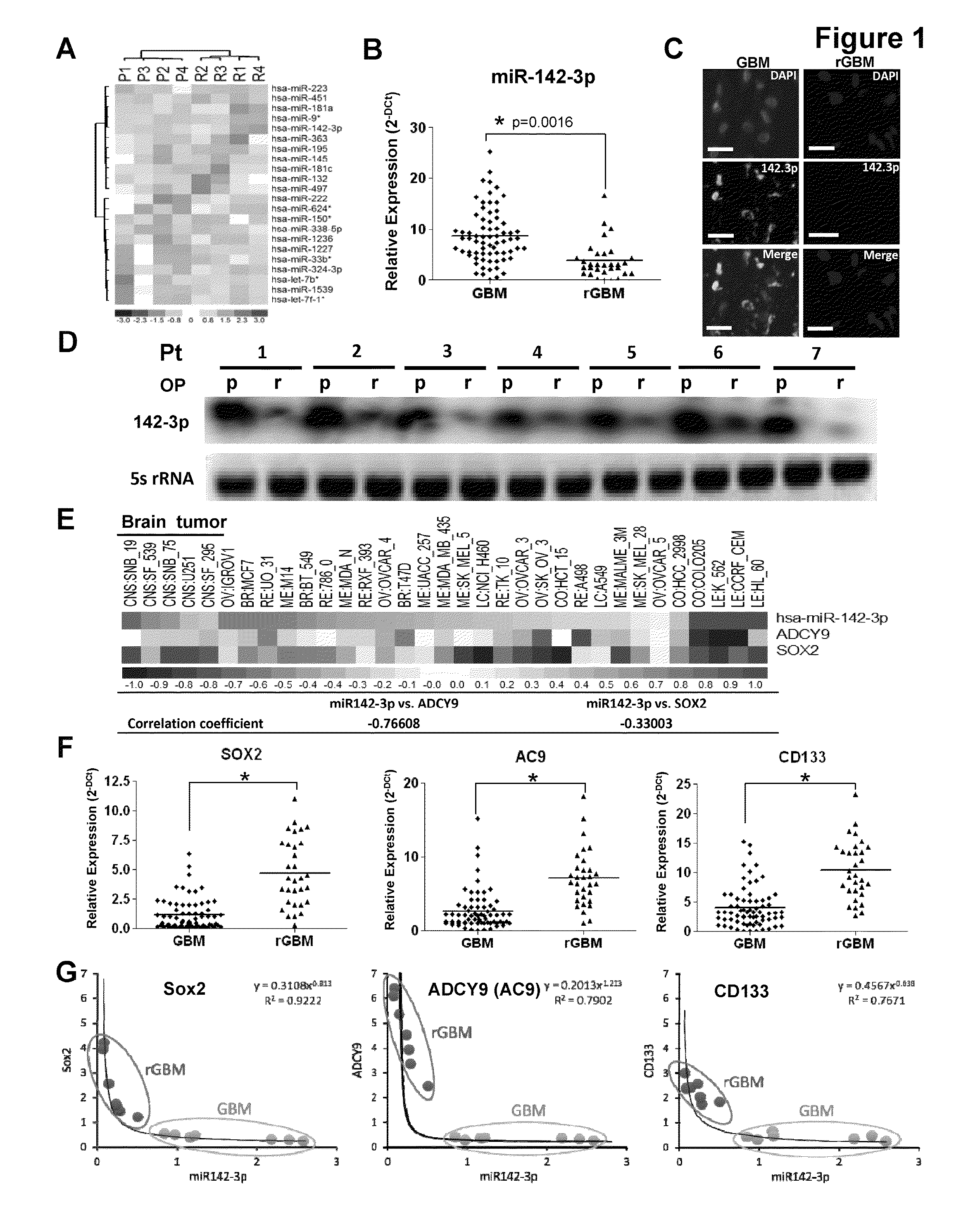MicroRNA as a cancer progression predictor and its use for treating cancer
a cancer and cancer technology, applied in the field of microrna as a cancer progression predictor, can solve the problems of mir34 overexpression impairing the self-renewal properties of brain tumor and pancreatic cancer stem cells, and lack of suitable markers, and achieve the effect of modulating tumor-initiating properties
- Summary
- Abstract
- Description
- Claims
- Application Information
AI Technical Summary
Benefits of technology
Problems solved by technology
Method used
Image
Examples
example
Example 1
Clinical Significance of miR142-3p Expression in Recurrent GBM
[0098]Glioblastoma multiforme (GBM) bears a very dismal prognosis with a rapid evolution and relapse within the first year even with complete resection followed by adjuvant chemoradiation. Some studies have suggested that these aggressive and recurrent GBM may be attributed to the persistence of cancer stem cells (CSC) (also known as tumor initiating cells (TIC)). A recent study has shown that microRNAs are involved in regulating or activating CSC properties in malignant cancers. However, the role that microRNAs play in modulating or generating CSCs in GMB, leading to relapse and resistance to conventional therapeutics, is still blurred. This invention sought to answer this critical question by elucidating the role of miRNAs in GBM recurrence. Initially, the miRNA expression profiles between primary and recurrent GBM from the same patient in four independent cases were compared, and it was found that 22 miRNAs we...
example 2
Combined High Expression of Sox2 and AC9 Predicts GBM Patient Prognosis, Survival, and Relapse
[0102]Since there was an inverse correlation between mir142-3p and Sox2, AC9, CD133, and GBM progression or recurrence, what was next sought was to determine the relationship between expression of these molecules and GBM patient outcome. Expression of Sox2, AC9, CD133 and miR142-3p was examined by immunohistochemical staining and FISH, respectively, in a specimen array panel from the 7 GBM patients (FIG. 2A, one representative case shown in A). Elevated Sox2, AC9 and CD133 expressions were all positively associated with recurrent, poorly differentiated GBM tissues when comparing recurrent (second surgery) with primary (first surgery) GBM specimens (FIG. 2A, B). In line with previous data, there was also a significant inverse correlation between GBM recurrence and the level of miR142-3p (FIG. 2A, B). To determine the prognostic significance of Sox2, AC9, CD133 and miR142-3p expression levels...
example 3
MiR142-3p Directly Targets the 3′ UTR Regions of Sox2, AC9, and CD133
[0104]The inverse correlation between miR142-3p and Sox2, AC9, and CD133 prompted the investigation of whether Sox2, AC9 and CD133 are directly targeted by miR142-3p. Luciferase reporter plasmids containing wild-type (WT) (SEQ ID NOS. 60-62) or serial deleted forms (D1-D5) of the 3′UTR regions of Sox2, AC9, and CD133 (FIG. 3A-C, right) were constructed. The luciferase reporter assay was performed by co-transfecting the reporter plasmids with or without miR142-3p in the cultured recurrent GBM cells isolated from patient samples (FIG. 3A-C, left). The results indicated that miR142-3p targeted Sox2 3′ UTR near its 3′ end (FIG. 3A), and AC9 3′ UTR at the region between D1 and D2 (FIG. 3B), though miR142-3p targeting sequence was not identified in both 3′UTR sequence by the Targetscan prediction program (www.targetscan.org). Moreover, as predicted by the Targetscan program, miR142-3p targeted the CD133 3′ UTR region, an...
PUM
| Property | Measurement | Unit |
|---|---|---|
| thickness | aaaaa | aaaaa |
| temperature | aaaaa | aaaaa |
| image acquisition time | aaaaa | aaaaa |
Abstract
Description
Claims
Application Information
 Login to View More
Login to View More - R&D
- Intellectual Property
- Life Sciences
- Materials
- Tech Scout
- Unparalleled Data Quality
- Higher Quality Content
- 60% Fewer Hallucinations
Browse by: Latest US Patents, China's latest patents, Technical Efficacy Thesaurus, Application Domain, Technology Topic, Popular Technical Reports.
© 2025 PatSnap. All rights reserved.Legal|Privacy policy|Modern Slavery Act Transparency Statement|Sitemap|About US| Contact US: help@patsnap.com



